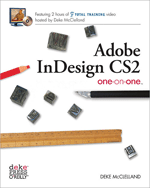Book Review
Adobe InDesign CS2 One-on-One

Adobe InDesign CS2 One-on-One is 528 pages of extremely intuitive training for Adobe’s page-layout application. It truly is the book I wish I had when I first started using InDesign several years ago.

Admittedly, today I’m quite accomplished in the use of InDesign and fully understood probably 90% of the material in this book. This did not, however, make it any less enjoyable to read. The lessons reinforced what I have taught myself over the years, and they offered juicy morsels that I did not previously know.
Novices to InDesign will appreciate the structure of the 12 lessons in this book. Following an introduction, each lesson clearly outlines what you’ll learn and concludes with a quiz to help you retain what you’ve learned. You’ll want to keep your computer—with InDesign running—within reach. The clear steps of each tutorial are easy to understand, but are best comprehended when you actually perform the steps yourself.
On practically every page, the tutorials are dressed with full-color images, mostly screen shots. There are enough images that go along with the lessons to help ensure you don’t get lost while following the tutorial steps, while not needlessly cluttering the page with a shot of every menu that is clearly described in the text.
Also of benefit are the liberal appearances of “Pearls of Wisdom,” which go into greater detail of a topic, but can be skipped without fear of not understanding the lesson.
Keeping to the classroom-style presentation both the book and video lessons employ, there are a number of “Extra Credit” sections, benefitting those who can’t absorb enough of the primary instruction. These are the parts where even someone with a lot of InDesign experience is likely to find some gems of new information.
Fans of the Total Training series will be thrilled to learn that the book includes a DVD-ROM that not only contains all the documents and support files for each lesson, but also more than two hours of video hosted by the author himself. And we’re not talking about dwarfish, highly compressed, thumbnail videos. Even though the DVD is intended to be used on a computer and does not play on television DVD video units, the video files are full-size resolution at 30 frames per second with no blatantly visible compression artifacts. Every detail of the palettes shown during the video tutorials is clear.
The video lessons were so helpful to me that I found myself wishing the entire book was available in video format. Yes, Total Training has a complete, 16-hour InDesign training video but, judging from its sample clips, I’d much rather listen to McClelland.
As much as I loved the book and am liable to keep it handy at work as a reference, a couple things bugged me. For beginners and novices, this doesn’t really matter, but I saw no reason to advise some adjustments to color workflow settings in an attempt to make the lessons on your screen appear to match the color of the book. Even if the press that printed the book were dead-on accurate, there’s no accounting for a reader’s monitor that isn’t properly calibrated, nor the color temperature of the lights under which the book is being viewed. This section should either have explained how to work with your press to determine the best color settings, or it simply should have been left out.
On the topic of color, it seemed somewhat bizarre for a particular point in a video lesson to suggest that there are times it’s okay to use 100% of all four process colors (400% ink density). Fortunately, the final video lesson does cover ink density and hints that most presses need it to be under 300%.
In addition to color adjustments, the author also provided a file on the DVD-ROM to make small tweaks to the keyboard shortcuts. I applaud the effort of changing some obscure shortcuts to a more civilized keystroke and adding shortcuts to a few commands that need them. However, for us slightly more advanced users, I’d have appreciated an appendix or something listing all the modifications in case there are some I’d rather leave alone.
I was hoping the book would include a lesson on grid layouts. InDesign’s ability to manage grids is fairly powerful, and it was a little stunning to read in the preface that grids would, quite specifically, not be covered.
And finally, to find typos in a book that has an entire tutorial on the use of spell check just seems unpardonable. Missing a homonym could perhaps be forgiven, but finding “iincorrect” on page 282 is something of an ironic double whammy!
Let me remind you, however, that I still offer high marks for this book. O’Reilly has a well-known reputation of publishing quality books with very helpful information, tutorials, and support material. Adobe Indesign CS2 One-on-One is no exception. This latest of more than 80 titles authored by McClelland—an accomplished and popular electronic publisher and lecturer—combines a clear writing style, hundreds of screen shots, and well-produced video lessons, making this book a resource any InDesign fan would be proud to own.
Reader Comments (3)
The interface can run off the DVD, but has an installer to put components on your hard drive to make it run more smoothly. This is probably only needed for pre-G5 machines. Once running, it provides an interface that allows for simple access to the topics, as well as a bookmarking feature. Therefore, I do recommend using the interface.
However, if you truly want to geek out, the videos are simple Sorensen-compressed Quicktime files. They're not accessible by default, but if you enable viewing of hidden files, you'll find the folder in which they reside.
Here's a sample of what the interface looks like. This shot is showing Adobe Premiere Pro and not InDesign CS2, but the interface is identical. The lower portion controls video playback and the upper portion is for topic navigation and bookmarking.
Add A Comment